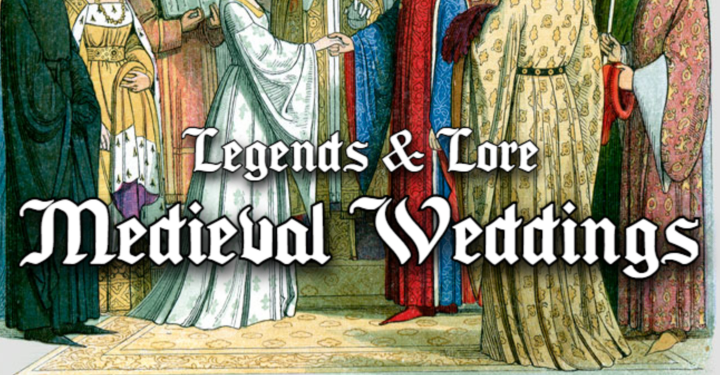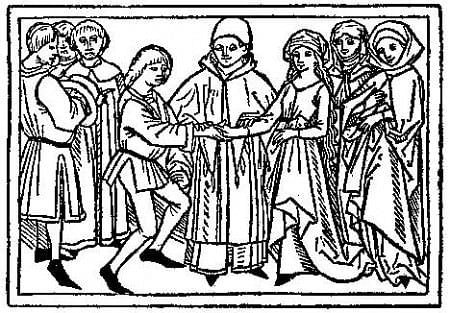
Legends & Lore: Medieval Weddings
With love still lingering in the air after Valentine’s Day we found it appropriate to dive into a more romantic Legends & Lore topic this week – Medieval Weddings. Ravenwood Castle makes for a one-of-a-kind wedding destination, and while it isn’t required to have a wedding with medieval touches or garb, many couples love to utilize the backdrop of the Castle for those reasons. Nowadays when the wedding ceremony concludes guests can game the night away in the Pub, but that isn’t exactly how it went back then. Let’s take a closer look at some medieval wedding traditions and see if any of them carried over to modern day practices!
Weddings in the Middle Ages didn’t always have a romantic backstory. You couldn’t go to The Knot and read about how the couple met. It may be surprising, but most couples didn’t marry out of love, but necessity or business. While this was dependent on class, it was not uncommon to see many couples wed for more practical reasons no matter where they fell on the social scale. It was more common for those of a lower social standing to marry for love, but that isn’t to say that arranged marriages didn’t happen. A substantial dowry or any significant landholding may sway the lower class families to go this route, but it was far more common that nobility had arranged marriages in order to exchange property or build upon business relationships. Sometimes marriages would be planned extremely early and in some instances the couple would not even meet until their wedding day.
It wasn’t until around the 16th century that marriages were required to be performed by a priest. For the nobility, it wasn’t required to get married in a church as long as the wedding was blessed by a priest. Otherwise, a wedding notice would be posted on the church for the lower classes so that if anyone had an issue with the marriage they could speak up. For instance, if a couple was too closely related or if someone was breaking any religious vows, this was grounds to object to the marriage. The ceremony would happen on the front doors of the church, or in the bride’s family home, and afterwards the couple would head into the church for a nuptial mass.
One fact that I found particularly fascinating was that the Middle Ages brought about the custom of the bride standing on the left side of the altar during the ceremony which we still see today. This came was due to the belief that Eve was created out of Adam’s left rib. It was deemed necessary for the man’s fighting arm (his right arm) to be ready at any time should someone object to the marriage and try to steal the bride away.

However, not every medieval wedding was tied to the church. It can get tricky when looking at weddings in the Middle Ages since a lot changed over that span of time, but it should be noted that sometimes a more informal marriage would occur. Mutual consent was a key factor in marriages even back then but before the growth of more official wedding documents, mutual consent and wedding consummation alone was considered a valid wedding contract. But without documentation or witnesses, this was fairly difficult to prove if one party came forward claiming the alleged vows to be untrue.
For the elite, the celebrations were magnificent. The ceremony and grand party afterwards was typically held in a manor or, you guessed it, a castle! The impressive feast would be followed with entertainment, and drinks were never in short supply. While there were no invitations sent out for the affair, those who lived at the residence, others of the same social class, and relatives were the primary guests. Beggars would always be waiting outside in hopes of being granted some leftovers. Mulled wines, meads, and ciders would flow, and celebratory dancing would help keep guests busy. Guests would bring small cakes and stack them atop one another, and the couple would then try to kiss over the cakes and make an effort to keep them from toppling as such wreckage would certainly bring bad luck! This concept helped influence the popularity of tiered wedding cakes today.
When researching I found a description of a more modest meal that was provided by a wealthy Italian businessman for his wedding day comprising of 406 loaves, 250 eggs, 100 pounds of cheese, two quarters of oxen and 16 of mutton, 37 capons, 11 chickens, 2 boars heads and feet for jelly, an unspecified number of pigeons and waterfowl, local provincial wines and Chianti imported from Tuscani. Imagine what splendor must have been involved in a more royal affair!
In concerns to attire, those of a noble class, more often than not, commissioned new clothing to be made for their special day. Their garb was typically more opulent and flashier. Many brides of a higher class went for red or golden hues when selecting their dress and indulged in velvet, satin, and silk designs. Sometimes these dresses would cost more than what a peasant might earn in an entire year! Color played a much more symbolic role when picking out attire for such an important event. Blue was considered the most popular color for brides to wear as it symbolized purity and explains the lore behind the “something blue” concept some couples still utilize today. Lower classes opted for wearing the piece they used for every special occasion (such as going to church), typically made from cotton. Whatever the case, the wedding day was seen as a very important day which meant dressing your best (or the best that you could). The cotehardie became a favorite for brides as more form fitting clothing gained popularity. Grooms also utilized a style of cotehardie and over time it grew shorter and shorter in length resulting in something we recognize: a tuxedo vest or jacket.
For the wedding day a bride would be covered in cosmetics and would pay close attention when it came to plucking her hairline. During that time high foreheads were considered to be a standard of beauty and brides did what they had to do to achieve that look. Their hair would be worn loosely and sometimes a floral wreath would sit atop the head.
The lore behind what we know and can conclude about medieval weddings is lengthy, but we hope that you learned something new this week on Quoth the Raven. If you or anyone you know is looking to host their own medieval celebration, you know where to send them. Ravenwood Castle provides a charming setting in the middle of the breathtaking Hocking Hills – check out more about our weddings by clicking here or emailing info@ravenwoodcastle.com.


 Quoth the Raven
Quoth the Raven